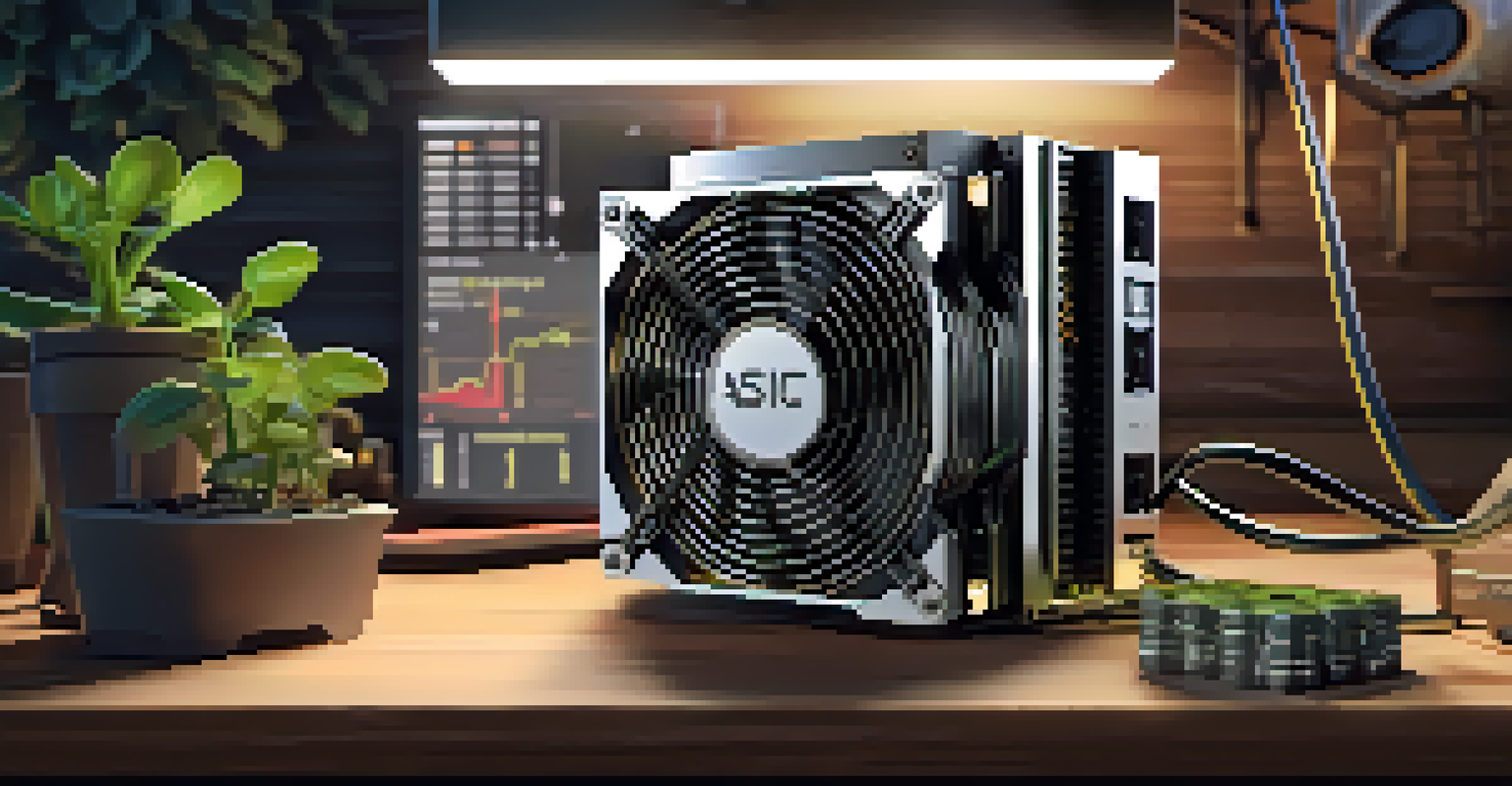Comparative Analysis of Bitcoin Mining Hardware Options Available

Understanding Bitcoin Mining: A Quick Overview
Bitcoin mining is the process of validating transactions on the Bitcoin network and adding them to the blockchain. Miners use powerful computers to solve complex mathematical problems, and in return, they are rewarded with newly minted bitcoins. This process not only secures the network but also introduces new bitcoins into circulation, making it a vital part of the ecosystem.
Bitcoin is a technological tour de force.
As Bitcoin's popularity has surged, so has the competition among miners, leading to the need for more efficient hardware. This is where specialized mining equipment comes into play, designed specifically to maximize hashing power while minimizing energy consumption. Understanding the basics of mining is essential before diving into the various hardware options available.
In the world of Bitcoin mining, the hardware you choose can make a significant difference in your profitability. With various options available, from consumer-grade hardware to industrial machines, it's crucial to evaluate the features and capabilities of each to determine which is best suited for your needs.
Types of Bitcoin Mining Hardware Explained
Bitcoin mining hardware primarily falls into three categories: CPUs, GPUs, and ASICs. CPUs, or central processing units, were the original mining hardware but are now largely obsolete for this purpose due to their low efficiency. GPUs, or graphics processing units, offer better performance and can also be used for gaming, making them a popular choice among hobbyist miners.

However, the most efficient type of hardware for Bitcoin mining today is ASICs, or application-specific integrated circuits. These machines are built specifically for mining and are designed to perform only that function at maximum efficiency. While they can be more expensive upfront, their superior hashing power often results in quicker returns on investment.
Importance of Efficient Hardware
Choosing the right Bitcoin mining hardware, such as ASICs, can significantly impact profitability and operational efficiency.
Each type of hardware has its advantages and disadvantages, and the choice often depends on your mining goals, budget, and energy costs. Understanding these categories is vital in making an informed decision about which hardware to invest in.
Evaluating ASIC Miners: Power and Efficiency
ASIC miners are the gold standard in Bitcoin mining due to their unparalleled efficiency. When evaluating these machines, two key metrics to consider are hash rate and power consumption. The hash rate indicates how many calculations a miner can perform per second, while power consumption determines how much electricity the miner will use, impacting overall profitability.
Mining is an essential part of the Bitcoin ecosystem, providing security and transparency.
For example, a miner with a hash rate of 14 TH/s (terahashes per second) and a power consumption of 1400W will be more profitable than one with a lower hash rate and higher power consumption. This balance between performance and energy efficiency is crucial for determining the potential return on investment.
Additionally, as the Bitcoin network adjusts its difficulty every two weeks, miners must stay competitive. Therefore, investing in the latest ASIC technology can provide a significant edge in the ever-evolving world of Bitcoin mining.
Popular ASIC Miners on the Market Today
Several ASIC miners have gained popularity among Bitcoin miners due to their efficiency and performance. The Bitmain Antminer S19 Pro is one of the leading models, boasting a hash rate of 110 TH/s and an energy efficiency of around 29.5 J/TH. This unit has become a benchmark for many miners due to its strong performance and relatively good return on investment.
Another notable option is the MicroBT Whatsminer M30S, which achieves a hash rate of 86 TH/s with a similar energy efficiency. Many miners appreciate its reliability and ease of setup, making it a favorite for both new and seasoned miners alike. It's essential to compare these leading models based on your specific needs and budget.
Energy Costs Affect Profitability
Miners must carefully consider energy costs, as lower electricity prices can lead to a competitive advantage in mining operations.
In addition to these popular models, other manufacturers are also entering the market with innovative solutions. Keeping an eye on new releases can be beneficial as technology continues to advance and improve mining efficiencies.
The Role of Energy Costs in Mining Profitability
Energy costs play a critical role in determining the profitability of Bitcoin mining operations. The price of electricity varies significantly depending on your location, which can impact your overall expenses. Miners in regions with lower energy costs often have a competitive advantage, as their operational costs are significantly reduced.
When calculating profitability, it's essential to consider both the electricity cost per kilowatt-hour and the power consumption of your mining hardware. For example, if your mining rig consumes 1400W and your electricity cost is $0.10 per kWh, your daily energy expense would be approximately $3.36. This number must be weighed against your potential earnings from mining.
As miners seek to maximize profits, some are exploring alternative energy sources, such as solar or wind power. This shift not only helps in reducing costs but also aligns with environmentally-friendly practices, making it an attractive option for those looking to sustain their operations long-term.
Assessing the Initial Investment for Mining Hardware
The initial investment for Bitcoin mining hardware can vary widely, depending on the type of equipment you choose. While consumer-grade GPUs may be more affordable, they often come with reduced hashing power compared to ASIC miners. Investing in high-quality ASICs typically requires a more substantial upfront cost but can lead to greater long-term profitability.
It's also important to factor in additional expenses, such as cooling systems, power supplies, and potentially even rental costs for space if you're operating on a larger scale. These additional investments can add up quickly, so it's crucial to create a comprehensive budget before diving into mining.
Future of Mining Innovations
Ongoing advancements in technology aim to enhance mining efficiency while addressing environmental concerns in the Bitcoin mining industry.
Ultimately, the goal is to ensure that your total investment aligns with your expected returns. Conducting thorough research and market analysis will help you make informed decisions and set realistic financial expectations.
Future Innovations in Bitcoin Mining Hardware
The world of Bitcoin mining is continuously evolving, with technological advancements paving the way for more efficient hardware. Future innovations may focus on increasing hashing power while reducing energy consumption, addressing one of the industry's biggest challenges. Companies are also exploring ways to integrate AI and machine learning to optimize mining operations further.
Moreover, as environmental concerns surrounding mining grow, many manufacturers are looking into sustainable practices. This includes developing hardware that can operate on renewable energy sources or improving energy efficiency to lessen the carbon footprint associated with mining activities.

Staying informed about these innovations will be essential for miners looking to maintain a competitive edge. As the landscape shifts, those who adapt to new technologies and practices will likely thrive in the ever-changing world of Bitcoin mining.